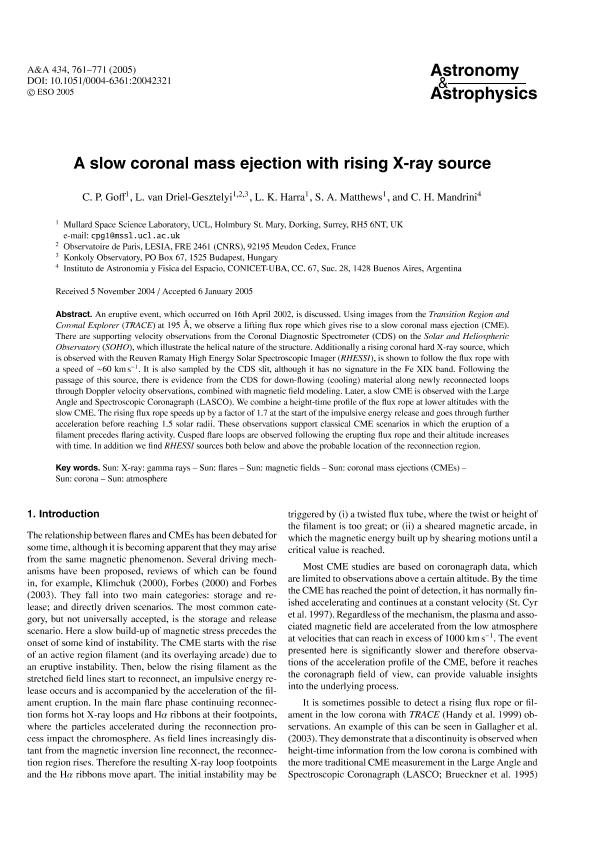Mostrar el registro sencillo del ítem
dc.contributor.author
Goff, C. P.
dc.contributor.author
van Driel Gesztelyi, Lidia

dc.contributor.author
Harra, L. K.
dc.contributor.author
Matthews, S. A.
dc.contributor.author
Mandrini, Cristina Hemilse

dc.date.available
2017-07-26T14:27:58Z
dc.date.issued
2005-12
dc.identifier.citation
Goff, C. P.; van Driel Gesztelyi, Lidia; Harra, L. K.; Matthews, S. A.; Mandrini, Cristina Hemilse; A slow coronal mass ejection with rising X-ray source; EDP Sciences; Astronomy and Astrophysics; 434; 2; 12-2005; 761-771
dc.identifier.issn
0004-6361
dc.identifier.uri
http://hdl.handle.net/11336/21323
dc.description.abstract
An eruptive event, which occurred on 16th April 2002, is discussed. Using images from the Transition Region and Coronal Explorer (TRACE) at 195 Å, we observe a lifting flux rope which gives rise to a slow coronal mass ejection (CME). There are supporting velocity observations from the Coronal Diagnostic Spectrometer (CDS) on the Solar and Heliospheric Observatory (SOHO), which illustrate the helical nature of the structure. Additionally a rising coronal hard X-ray source, which is observed with the Reuven Ramaty High Energy Solar Spectroscopic Imager (RHESSI), is shown to follow the flux rope with a speed of ~60 km s<sup>-1</sup>. It is also sampled by the CDS slit, although it has no signature in the Fe XIX band. Following the passage of this source, there is evidence from the CDS for down-flowing (cooling) material along newly reconnected loops through Doppler velocity observations, combined with magnetic field modeling. Later, a slow CME is observed with the Large Angle and Spectroscopic Coronagraph (LASCO). We combine a height-time profile of the flux rope at lower altitudes with the slow CME. The rising flux rope speeds up by a factor of 1.7 at the start of the impulsive energy release and goes through further acceleration before reaching 1.5 solar radii. These observations support classical CME scenarios in which the eruption of a filament precedes flaring activity. Cusped flare loops are observed following the erupting flux rope and their altitude increases with time. In addition we find RHESSI sources both below and above the probable location of the reconnection region.
dc.format
application/pdf
dc.language.iso
eng
dc.publisher
EDP Sciences

dc.rights
info:eu-repo/semantics/openAccess
dc.rights.uri
https://creativecommons.org/licenses/by-nc-sa/2.5/ar/
dc.subject
Coronal Mass
dc.subject.classification
Astronomía

dc.subject.classification
Ciencias Físicas

dc.subject.classification
CIENCIAS NATURALES Y EXACTAS

dc.title
A slow coronal mass ejection with rising X-ray source
dc.type
info:eu-repo/semantics/article
dc.type
info:ar-repo/semantics/artículo
dc.type
info:eu-repo/semantics/publishedVersion
dc.date.updated
2017-07-25T14:51:26Z
dc.journal.volume
434
dc.journal.number
2
dc.journal.pagination
761-771
dc.journal.pais
Francia

dc.journal.ciudad
Paris
dc.description.fil
Fil: Goff, C. P.. Mullard Space Science Laboratory; Reino Unido
dc.description.fil
Fil: van Driel Gesztelyi, Lidia. Centre National de la Recherche Scientifique. Observatoire de Paris; Francia
dc.description.fil
Fil: Harra, L. K.. Mullard Space Science Laboratory; Reino Unido
dc.description.fil
Fil: Matthews, S. A.. Mullard Space Science Laboratory; Reino Unido
dc.description.fil
Fil: Mandrini, Cristina Hemilse. Consejo Nacional de Investigaciónes Científicas y Técnicas. Oficina de Coordinación Administrativa Ciudad Universitaria. Instituto de Astronomía y Física del Espacio. - Universidad de Buenos Aires. Facultad de Ciencias Exactas y Naturales. Instituto de Astronomía y Física del Espacio; Argentina
dc.journal.title
Astronomy and Astrophysics

dc.relation.alternativeid
info:eu-repo/semantics/altIdentifier/doi/http://dx.doi.org/10.1051/0004-6361:20042321
dc.relation.alternativeid
info:eu-repo/semantics/altIdentifier/url/https://www.aanda.org/articles/aa/abs/2005/17/aa2321/aa2321.html
Archivos asociados
